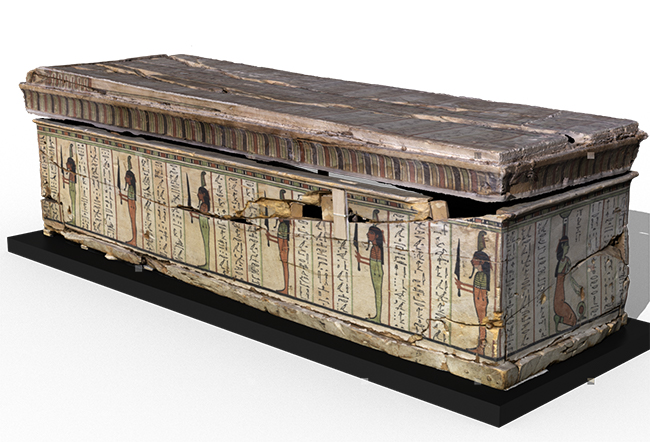anx-wnn-nfr
This coffin is part of a nested set of two coffins. See the inner coffin here.
The two nested coffins of Ankh-wenennefer, the innermost of which still houses Ankh-wenennefer’s remains, were purchased in 1891 by Allen C. Mason. Mason was a real-estate developer and entrepreneur whose marketing efforts and infrastructure projects helped to build his home city of Tacoma, Washington. Mason’s record of his purchase survives and tell us that he bought the coffin from the dealer “Moharb Todrous” in Luxor. This is certainly Mohareb Todros, who was a German Consular Agent in Luxor and also a prominent antiquities dealer in a family of Consular Agents/Dealers.1 As for Ankh-Wenennefer, he was not actually from Luxor. The titles on his coffin indicate he held priestly titles in the temples at Akhmim, some 200 km north of Luxor. It seems likely that his coffin was unearthed in the excavations that devastated the large cemeteries of Akhmim in the 1880s.
The coffins (and their occupant) were briefly exhibited in Tacoma at the “Western Washington Industrial Exposition” in 1892—this was a showcase for art, culture, industry…and an advertisement for local businesses.2 They were then donated to the Washington State Historical Society, where they remained aside from some short loans and a 22-year loan to the University of Puget Sound from 1959-1981.
The inner coffin can probably be dated to the timespan between the 26th and 30th dynasty, according to Ruth Brech’s typology of coffins from Akhmim, in which Ankh-Wenennefer’s inner coffin more or less fits into Type B.3 However, Ankh-Wenennefer has an outer coffin, which is unusual for this type of coffin. The orientation of the mummiform protective deities on the body, which face the central column, are also unusual for this type, wherein the figures are usually rotated 90 degrees perpendicular to the central columns.
As for Ankh-Wenennefer himself, we mainly know what his coffin tells us. He held several titles at Akhmim including Stolist Priest at Akhmim (smAty n Ipw) , and Hm-nTr for Min and Horus-Who-Protects-His Father—two important local deities at Akhmim. He may also have held a priestly office at Dendara.4 His mother’s name is unusual and doesn’t have any parallels that we know of. It seems to be Tatjaw (tA (n.t) TA=w). His father and grandfather were both Hm-nTr priests in Akhmim of the same rank. Their names were Wennennefer and Ankhwenennefer respectively. It is difficult to confirm that either ancestor is definitively attested on another monument--both names are common in the Late Period,5 but Ankhwenennefer of Tacoma may be related to the owner of a coffin in the British Museum, Irethoreru (EA 20745). Irethoreru’s father was a Hm-nTr priest of the second phyle at Akhmim named Ankhwenennefer.6
The outer coffin, as mentioned above, is unusual in that most coffins of this type don't have one. The inside is unpainted, and the lid has been heavily damaged. In fact, the lid is now held together by a plexiglas frame, which has been edited out of the model, but which has left artifacts on the model of the lid. (See Technical Notes for more detail.)
Ankhwenennefer’s coffins will be discussed in more detail in Kea Johnston’s forthcoming doctoral dissertation at the Universit of California, Berkeley, on first millennium BC coffin workshops at Akhmim.
- 1 Fredrik Hagen and Kim Ryholt, The Antiquities Trade in Egypt 1880-1930: The H. O. Lange Papers., Scientia Danica, 8 (Copenhagen: Royal Danish Academy of Sciences and Letters, 2016), pp. 249–50.
- 2 ‘Western Washington Industrial Exposition Building, 1891’ [accessed 27 May 2020]; ‘Washington State Historical Society > Collections > Official Prospectus of the Western Washington Industrial Exposition’ [accessed 27 May 2020].
- 3 Ruth Brech, Spätägyptische Särge Aus Achmim, Aegyptiaca Hamburgensia, 3 (Gladbeck: PeWe Verlag, 2008), pp. 116–27.
- 4 The title Hm-nTr n xnsw n pA-iwn-tr is unusual and may be associated with Dendara. See LGG V p 763.
- 5 Ankhwenennefer: PN I p 63, #9, Wenennefer: PN I p79, #19.
- 6 This was first suggested by Dr. John H. Taylor of the British Museum in a communication with the Kelowna Museum of Kelowna British Columbia on 9/29/1992, when the coffin was on loan to this museum.
Unpublished
